First postwar cruiser in Germany, the Emden (from the city, also to honour the famous 1914 corsair cruiser was authorized in 1921 in an unfavourable economic environment and suspicious allies. Emden was directly modelled after the last german cruisers built in WWI, the “Königsberg II” and the projected 1916 Flottenkreuzer (FK1) Entwurf 1916. Configuration of the main armament and general arrangements reflected this, but she also tested an-all diesel powerplant for extra range. At least she served as a validation for German shipbuilding capacity, and was used to train cadets for the future Kriegsmarine, showcased in long international cruises and goodwill ship for the Weimar Republic. In WW2 she played various roles and was destroyed by a double air raid in April 1945 in Kiel. #kriegsmarine #germannavy #ermden #cruiser #kreuzeremden #schulschiff #ww2
Development
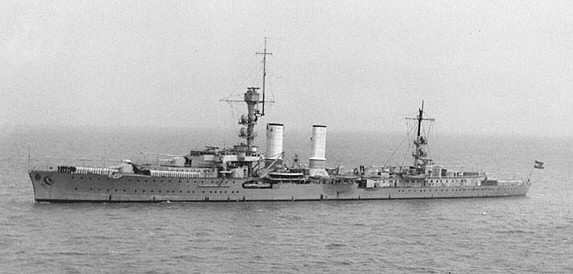
Emden in China, 1931
With Article 181 of the Treaty of Versailles, only six light cruisers were allowed to the new Reichsmarine. Article 190 also capped them to just 6,000 long tons (6,100 t) standard, and prohibited new constructions until the ship concerned was 20 years old (Ersatz). But as the best, most modern cruisers of the previous Kaiserliches Marine had been convoyed to Scapa Flow and scuttled, the new fleet of the Weimar Republic were those scheduled for retirement already, meaning dating back to 1899-1902, the Gazelle and Berlin class. Of the latter, RMS Niobe, Amazone, Nymphe, Thetis, and Medusa reached that limit and were scheduled for replacement. So Design work on a new light cruiser started in 1921 as ordered by Admiral Paul Behncke “Ersatz Niobe”.
The Navy planned to have her built in no time and for cheap and requested permission from the Naval Inter-Allied Commission of Control to use steam turbines but also the boilers and conning tower from just scrapped vessels, however the NIACC rejected thid request. The Navy then re-planned the ship as it would now be delayed, looking for an armament of four twin-gun turrets as the new trend seemed to go right there. Yet again, the NIACC rejected this design albeit authorizing the use of stock 15 cm (5.9 in) guns. There were still many “brand new” spare barrels still in the inventory indeed, for ships never completed and as wartime replacements for worn out ordnance.
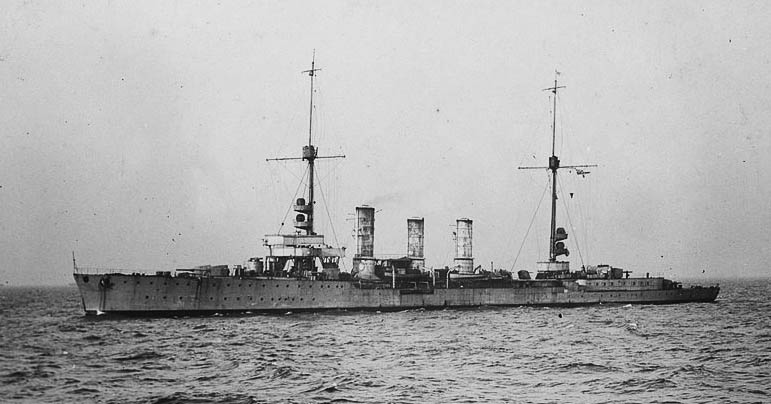
The previous Karlsrühe ii of the Königsberg (ii) class
Thus the new cruiser was well capped, which simplified design discussions to the minimum: Engineers were asked to not reach a 6,000-ton limit (assuled to be standard, not full load), use single-mounted 15 cm main guns and having to basically start again for the powerplant. Either with the choice of building new turbines and boilers at home, meaning re-learning some skills, or do something else entirely. Discussions with the allies went on however as in 1923, after work begun and the planned displacement was already at 7,000 tonnes, German delegates proposed a definition for standard displacement to precise dispositions of the Washington Naval Treaty of 1922, not standard but below close to full-load displacement. The Allied powers approved for Germany so that the standard 6,000-ton limit displacement was retroactively legalized.
Engineers retook the blueprints from the Karlsruhe ii, no the more advanced Flottenkreuzer (Entwurf 1916). This was to spare time in plans drawing as there was personnel shortages in the design staff whereas after the war, the former Imperial Ship Testing Institute was closed. Some plans evenn had been destroyed, lost, or jusr requisitioned by victorious powers, so only the blueprints for Karlsruhe were available and adapted. Thus of course was not pleasing the admiralty which will have a ship of dubious military value at a time 10,000 tonnes cruisers armed with 8-in (203 mm) guns were built left, front and center by naval powers.
She was a test ship, in large part made to recuperate experience in design and ship construction. And engineers managed to find a way to make a very improved “copy” of the Karlsruhe, as she was larger, rommier and incorporated major advances, notably by her all-welding construction which reduced weight and it was decided to test a more efficient propulsion system based on diesels, unlike WWI vessels, so to give her a 50% larger range compared to their forebears. However this was changed to two classic steam turbines, but with a mixed combustion of oil and coal, which proved be just perfect as a cadet ship, offering the latter world-spanning extended training cruises in the interwar. Experience proved invaluable to design the next class, whereas the new K class planned in 1925, also using welding and combining turbines and diesels and afterwards, the famous Deutschland class “pocket battleships”.

Emden’s massive replacement MAN diesel engines, never fitted, as preserved.
Design of the class
Hull and general design
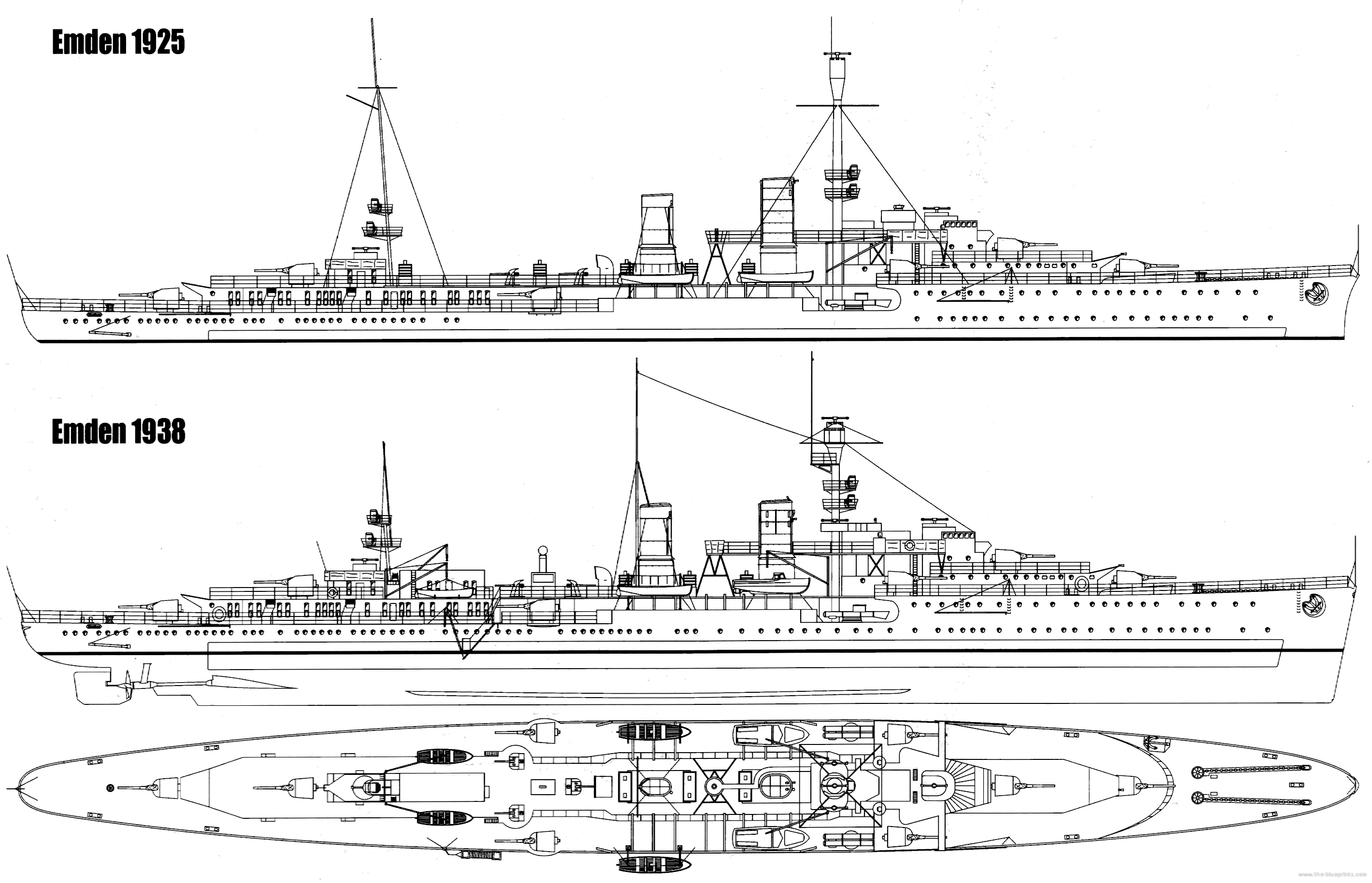
Emden in 1925 as built and as modernized in 1938
KMS Emden was longer than Karlsruhe, with a hull 150.5 meters (494 ft) long at the waterline, 155.1 m (509 ft) overall. The beam went to 14.2 m (47 ft), so again a bit larger () for a draft of 5.3 m (17 ft) standard, in regular order 5.15 m (16.9 ft) and in full combat load 5.93 m (19.5 ft). Designed displacement was 5,960 long tons (6,060 t) but it ended as 5,300 long tons (5,400 t) standard and went up to 6,990 long tons (7,100 t) fullu loaded, nearly 1,000 tonnes above the auhorized limits.
As she stands, Emden received a standard crew of 19 officers, 464 enlisted men in combat mode, but as a training ships for her long cadet training cruises, this amounted 39 officers and 445 enlisted plus 162 cadets.
Since she was slightly modernized, notably with AA, by 1940 she had 26 officers, 556 enlisted, an when demoted back as a training ship, 30 officers, 653 ratings. She had the accomodations for this but felt cramped anyway. As for her general appearance, the hull very likely resembled the Könisgberg ii, albeit longer, with superstructures for the axial main guns fore and aft, a prismatic bridge placed in front of the conning tower, topped by a standard B&S type rangefinder. Behind was located a ranging table. She only two funnels due to her new powerplant instead of three, but above all, had a thick military mast that did not existed on the former design. The latter supported an enclosed one-man spotting top and supported another telemeter. The aft mas was a simplepol, raked but of the same height. Both it and the foremast supported also two platforms each with projectors. There was a small quartedeck structure aft of the aft mast, then the two aft axial guns. The armament was the same as the Jonigsberg ii, eight guns total in single positions under masks but they were placed differently (see below).
She carried six boats: Four placed on davits abaft the funnels, and two small pinnaces aft.
Her appearance will change over time (see below).
Powerplant
KMS Emden was eventually not fitted only with diesels as main propulsion, although they were kept in reserve for future refitting. She instead was completed with a pair of Brown, Boveri & Co. geared steam turbines ordered in UK. They drove shafts with bronze three-bladed screws 3.75 m (12.3 ft) in diameter. Steam came from four coal-fired Marine-type water-tube boilers cast in Germany, and completed by six oil-fired Marine water-tube boilers placed into four separated boiler rooms for flooding redundancy.
This powerplant was rated at 46,500 shaft horsepower (34,700 kW), which procured a top speed of 29 knots (54 km/h; 33 mph). Speed trials, saw her reaching 45,900 shp (34,200 kW) and 29.4 knots (54.4 km/h; 33.8 mph). To compare the previous cruisers made 27 knots. She carried also 300 metric tons of coal with as each time a wartime additional reserve to push it to 875 metric tons (861 long tons). She also had oil bunkerage which was new compared to the previous ships, at 200 metric tons (197 long tons) as designed, and this went up to 1,170 metric tons using again additional fuel bunkers. In the end, between coal and oil she had the largest supply of any German cruiser so far, achieving a range of 6,700 nautical miles (12,400 km; 7,700 mi) at 12 knots (22 km/h; 14 mph) which was way more than the previous vessels (4,850 nautical miles or 8,980 km; 5,580 mi) but not twice as much as seen in some publications.
She also could cruise at high speed to 18 knots over 5,200 nmi (9,600 km; 6,000 mi) which was still much better than previous cruisers. She also needed more electrical power than WWI vessels and could count on the generous supply provided by two powerplants, counting three generators each for a total of 420 kilowatts (560 hp)/220 Volts. As far as seakeeping went, the was after trials considered in reports as a good sea boat, with “slight lee helm and gentle motion in a swell”. She was prediectible, agile, but slow when turning hard rudder, beeling speed at 60% as customary for a ship that had such hull lenght ratio, but less at moderate cruise, and in a head sea. Like previous cruisers she had a single large rudder and her metacentric height was just .79 m (2 ft 7 in) so she was a stable gun platform.
Armament
Main
Emden’s main battery initial armament of 15 cm SK L/55 guns in twin turrets was disallow and she returned to the proven solution of the Königsberg ii, with a configuration however different. The latter had indeed paired guns forward, but Emden being longer, the two forward guns were placed in the axis, in a superfiring pair. That was the biggest change as the aft guns were placed the usual way and there were four wings guns, two abaft the bridge on the forecastle like the previous ships, and two further aft, behind the funnel.
These were stock 15 cm SK L/45 guns, all single C/09 and later C/16 mounts with shield. Being shorter barrel meant shorter range.
Specs:
45 kg (99 lb) shell, muzzle velocity of 835 mpsd (2,740 ft/s).
Elevation 40°, Max range 17,600 m (57,700 ft).
960 rounds in total, HE and AP.
AA
The secondary armament was very much WWI in flavour, with two 8.8 cm SK L/45 on C/13 mounts anti-aircraft guns like former cruisers, but a third was later added. 900-1,200 rounds ammunition were carried. Needless to say past 1930, these guns were less relevant, and the post-1933 upgrades were to include a serious overhaul of the anti-aicraft defence.
TTs
As designed, they would have four twin turrets and four twin deck-mounted 50 cm (20 in) torpedo tubes. In 1925, they had all the four torpedo tubes banks. However later in their career the aft tubes were removed to lower displacement and regain in stability, only the forward twin banks were fitted as built. The particularity though was their location in a recess of the forecastle.
In 1934, the banks were replaced by 53.3 cm (21 in) equivalent, with a reserve of twelve torpedoes.
Upgrades
In 1931 Emden’s anti-aircraft battery looked woefully inadequate with the latest advanced in aviation and it was strengthened a first time. The forward torpedo tubes were replaced by modern 533mm ones and the third 88mm/45 SK C/13 was added on the centerline aft.
Next, in 1934, all boilers were converted to oil-burning, with the oil stowage pushed to 1,266t and the endurance 5300 nm at 18 knots.
During this upgrade, both funnels were shorted by 2 meters (6 ft 7 in), with gaffs for the wireless transmitters installed on the aft funnel.
In 1938, two 3.7 cm SK C/30 guns were installed and in 1939, four of them, plus six 2 cm/65 C/38 FLAK guns, for a start.
The deck was modified to have the capacity to carry 120 mines also in 1934-39.
In 1940 she had extra AA guns installed (contradiction in sources) and a degaussing coil installed above the waterline to protect her from magnetic mines.
1942 saw the largest change, with her remaining torpedo tubes removed, while she exchanged all her WWI stock 15 cm gun for the Tbts KC/36 model designed for destroyers and firing a slightly smaller 40 kg (88 lb) shell but at 875 m/s (2,870 ft/s) for better range and penetration. The gun mounts were modified as well as the shields to elevate to 47 degrees so that range jumped to 23,500 m (77,100 ft). She also received two quad 20mm/65 C/38 Flakvierling mounts, located on … and a FuMO 22 radar.
By early 1944, all ieght 149mm/42 were removed and replaced by the 149mm/46 Tbts KC/36 according to other sources, not in 1942.
By the Autumn of 1944 her three 88mm/45 were removed as well as her six 20mm/65 FLAK whereas three single 105mm/42 SK C/32 where installed in lieu of the 88, and two single 40mm/56 FlaK 28 were added as well as two single 37mm/80 SK C/30 FLAK as well as six twin 20/65 C/38 mounts. This was her greater extension of AA armament until she was sunk in Kiel.
In Feruary 1945 she had a FuMO 25 radar added.
Protection
Her hull was constructed with longitudinal steel frames with seventeen watertight compartments under the waterline, and double bottom above 56% of the keel. Protection was limited, with a waterline armored belt 50 mm (2 in) in thickness, an armored deck from 20 to 40 mm (0.79 to 1.57 in) thick depending on the location and a forward conning tower with 100 mm (3.9 in) walls. This was quite appreeciable and an upgrage over WWI cruisers.

Emden in 1939. She was apparently never camouflaged but perhaps according to this reference, with a dark central band to make it shorter.
KMS Emden specifications |
|
| Dimensions | 155.10 x14.30 x6.60 m |
| Displacement | 5,600t/6,900t FL |
| Crew | 650 |
| Propulsion | 2 screws, 2 Brown-Boveri turbines, 4 coil/6 fuel oil boilers, 45 900 cv |
| Speed | 29,4 knots (54 km/h; 34 mph) |
| Range | 6,700 nmi (12,400 km; 7,700 mi) at 15 knots (28 km/h; 17 mph) |
| Armament | 8 x 150 mm, 3 x 88 mm, 4 x 20 mm AA, 4 TT 533 mm (2×2) |
| Armor | Belt: 50 mm (2.0 in), Deck: 40 mm (1.6 in), Conning tower: 100 mm (3.9 in) |
Read More/Src
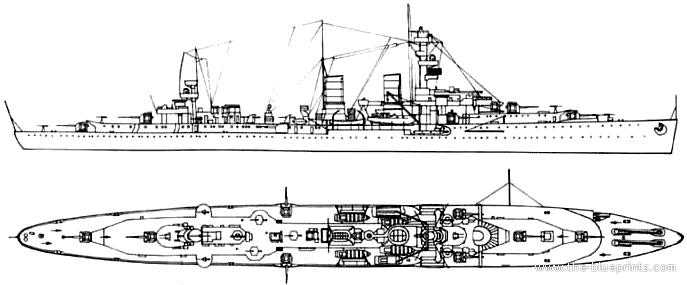
Emden in 1944
Books
Conway’s all the world fighting ships 1921-1947.
Links
The Emden on wikipedia
The Emden in World Naval ships
navypedia.org
Videos
Model Kits
3D
Gallery
Career of KMS Emden
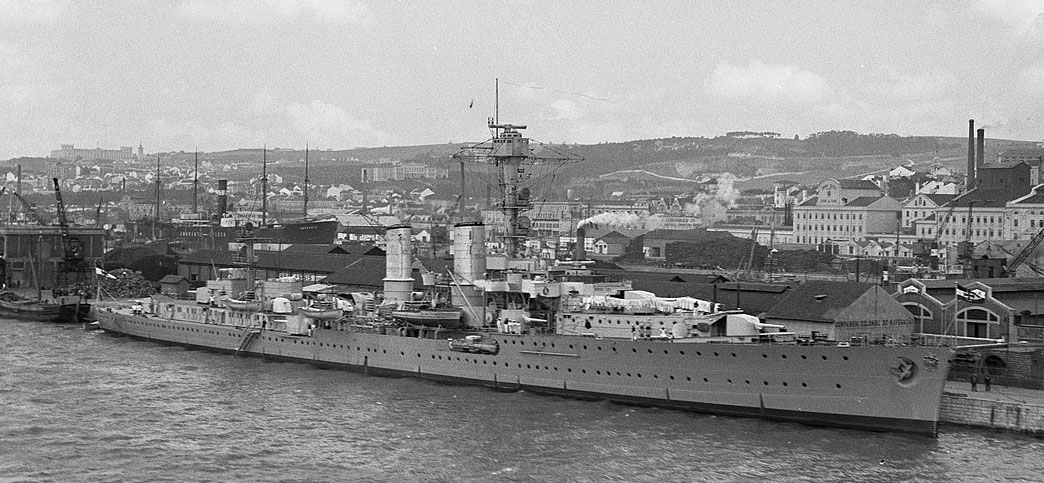

KMS Emden on her way to Oslofjord in March 1940 – notice the camouflage
KMS Emden was laid down at the Reichsmarinewerft shipyard (Wilhelmshaven) on 8 December 1921 but political instability plus financial issues delayed construction. She was eventually launched on 7 January 1925, after four years and under Admiral Hans Zenker, which gave a speech during the ceremony. She was christened by the widow of Karl von Müller commander of the original Emden, probably one of the most successful Von Spee’s commerce raider. During the war she played an essential role in diverting the allies in the Indian Ocean while Von Spee made a rush towards the south Atlantic. Emden was commissioned on 15 October 1925 and from the start she was to act as a training ship for naval cadets.
Interwar service
Her first assignation was the Marinestation der Nordsee and she started her sea trials interrupted with alterations at the Reichsmarinewerft. Notably her initial thick main mast was rebuilt. By 1926, after crew training she made a shakedown cruise including many ports visits still in northern European waters. August-September saw her in the annual fleet maneuvers. In October she was altered again, her aft funnel raised to match the forward one, and she was submitted afterwards to the Training Inspectorate of the Navy.
Her first long range cruise with cadets was on 14 November 1926, from Wilhelmshaven. She made the full circuit, along the western coast of Africa down to the cape and into Indian Ocean, stopping at the Cocos Islands to commemorate the destruction of her namesake and retreive some memorabilia from the wreck. After March 1927 she resumed her trip to East Asian waters, reached Japan and sailed across the northern Pacific Ocean, to Alaska and veered south from Seattle, down the western coast and stopping in all major ports along the way. She then went on along the South American waters, reached the good hope and crossed back north the Atlantic after a stop at Rio de Janeiro in Brazil on 25 December for some R&R. Via the Azores and Vilagarcía in Spain she made it back to Wilhelmhaven on 14 March 1928.
Her next cruise started on 5 December 1928 under command of illustrious WWI U-ace Lothar von Arnauld de la Perière, sailing to the Mediterranean Sea via Istanbul, and the Suez Canal, Indian Ocean, Dutch East Indies, Australia, Hawaii, west coast, Panama, Caribbean, Las Palmas and back to Wilhelmshaven, 13 December 1929 so nearly after a year.
On 13 January 1930, made her first trip across the Atlantic via Madeira, the Caribbean, New Orleans, Charleston, Kingston, San Juan, and back into the Atlantic, via Palmas and Santa Cruz de Tenerife to Wilhelmshaven, 13 May 1930. She underwent a massive overhaul and by October that year, Fregattenkapitän Robert Witthoeft-Emden (aptly named) took command.
Next 1931 cruise started on 1 December 1930, via Vigo, Spain, Mediterranean, Souda Bay (Crete), Suez, Aden, Cochin, Colombo, Trincomalee, Port Blair, Sabang, Bangkok, Victoria, Labuan, Manila, Nanking, Shanghai, Nagasaki, Osaka, Nii-jima, Tsuruga, Hakodate, Otaru, Yokohama, and Guam and back via the Indian Ocean, South Africa, Durban, then visited by officers in Johannesburg and greeted by PM J. B. M. Hertzog. Next she stopped along the west coast at Lobito, Luanda, Las Palmas, Santander and back on 8 December 1931.
Instead of the January 1932 cruise, Emden under FK Werner Grassmann, was reassigned to the Training Inspectorate, Commander, Reconnaissance Forces. At its head was Konteradmiral Conrad Albrecht. Training missiones with scouting forces and annual summer fleet maneuvers and training in the Atlantic (stopped at Funchal, Las Palmas) with KMS Leipzig. She was then decommissioned (1 April 1933) for a massive refit, at a time the Kriegsmarine, backed by Hitler against the allies, was in full modernrization and expansion. The extensive refit which ended on 29 September 1934, when she was commanded by FK Karl Dönitz (yes, this one). She went on with cruisers for the Training Inspectorate, on 10 November 1934, going as far as Cochin and when back, via the Mediterranean, Alexandria, Cartagena, and Vigo. She ended in the Schillig roadstead, Wilhelmshaven on 12 June 1935.
She started her sixt long cruise by 23 October under Kapitän zur See Johannes Bachmann, to the Americas via the Atlantic, refuelling in the Azores, West Indies, Venezuela, Panama to Guayaquil, in Ecuador, Puerto San José in Guatemala before and Portland, Oregon, then Hawaii. She was back to Central America, crossed Panama, West Indies, toured the US eastern coast and staying for public displays in Baltimore and Montreal. She stopped when back to Pontevedra, and arrived home on 11 June 1936. Next in 1936 she sailed under KzS Walter Lohmann from 10 October via the Mediterranean (Cagliari, Dardanelles, Bosporus, Black Sea, Varna, back and Suez, Ceylon, Thailand, China, Japan, Padang, Bombay, Suez Canal and back via Algeciras in April 1937, and to Voslapp in Germany then Wilhelmshaven on 23 April. The Spanish civil war broke out in between.
On 11 October 1937, Emden made her 8th cruise via the Mediterranean under FK Leopold Bürkner, this time staying off Spain for non-intervention patrols until 18 October, Suez Canal, Indian Ocean but also stopping at Massawa in Italian Eritrea, Colombo, Mormugao in India, Belawan and Surabaya in the Dutch East Indies. When back she stayed again a few days for non-intervention patrols 14-21 March 1938 before a halt at Amsterdam, anc back to Wilhelmshaven, 23 April.
June saw her prepared for her new cruise under KzS Paul Wever, starting 26 July to Norway, North Atlantic, Iceland (Reykjavik), south via Azores and Bermuda, Hamilton (30 August- 3 September) but her crew was booed due to recent developments and a shift in the international after the Sudeten crisis. The rest was cancelled, she was recalled via Funchal. The Munich Agreement was signed in between and she could resume her training cruise via the Mediterranean and Black Sea. In Istambul her crew wore the parade uniform for a ceremony on 19-23 October for the grand funeral for Mustafa Kemal Atatürk. While back in what was her last cruise, she stopped at Rhodes and Vigo. 29 March – 15 April 1939 saw the cancellation of any new cruise and instead she acted for fishery protection, only visiting Reykjavik. By May KzS Werner Lange and preparations for war were made. Some argued that due to her low value she could be decommissioned, to free crews for new ships. But the situation rapidly changed and in September, these plans were shattered;
Wartime service
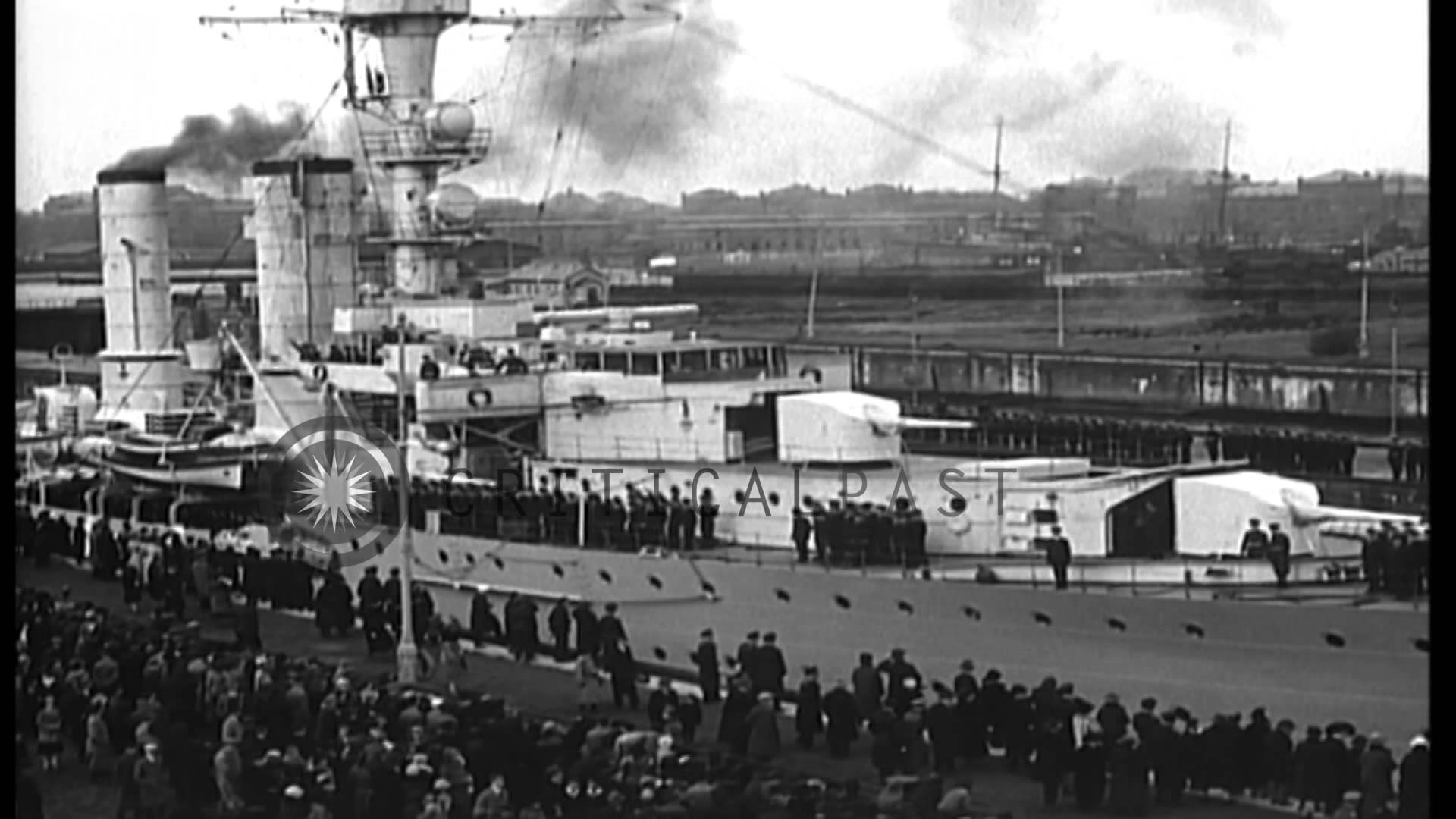
Video extract Ytube
Her first war mission was to lay a defensive minefield in the North Sea on 3 September accompanied by the light cruisers Nürnberg, Leipzig, Köln, and Königsberg plus no less than 16 destroyers. This long minefield stretched between the German Bight, the coast of the Netherlands, to the Jutland peninsula, to secure the Westwall seaward flank. Back to Wilhelmshaven new mines were installed, but while she was moored, the alarm started as ten British Blenheims from No. 107 and No. 110 RAF fell on them on 4 September. She shot down one with her 2 cm guns, but the bomber crashed into her starboard, but this contradicts reports from No. 107 squadron. Anyway, there was only superficial damage and a few casualties, the first of the German fleet in WW2.
Next she was assigned to the Baltic for commerce protection, had maintenance in Wilhelmshaven until 3 January 1940, training and spent the winter of 1939–1940,until mobilized for Operation Weserübung the Norwegian invasion. She was assigned to Group 5, tasked to seize Oslo. She was in Swinemünde on 12 March and was ready to depart with the heavy cruiser Blücher as flagship, the ex-Deustchland now Lützow, three Torpedo Boats, eight R-boote. The night of 5 April saw her close to the flagship in searchlight training and the day after, she embarked 600 soldiers and equipment in Swinemünde, before sailing to the gathering point at Strander Bucht, outside Kiel. 8 April in the afternoon, they steamed for Oslofjord, arriving at midnight.
In the approaches, Emden transferred 350 men to R-boats for landing ashore but all surprise was lost when Blücher was spotted, flashed, engaged and sunk by the Oscarsborg Fortress (Battle of Drøbak Sound). Lützow was also damaged. The attack was a failure the all forced turned back. Emden and Lützow landed their remaining troops further down to attack the coastal defenses from the rear and Emden and Lützow turned back and returned to Oscarborg fortress at 15:55, providing covering fire. Its garrison surrendered, followed by all forces on 9 April. On 10 April, Emden in port played the role of joint communications center for all three arms, relieved on 24 April, but staying in Oslo until 7 June, and hosting Großadmiral Erich Raeder on 17 May. She was back to Swinemünde on 8 June.
Until 15 February 1941, she was in training and drydock maintenance. By September 1941 she returned to the Baltic Fleet, escorting KMS Tirpitz, making a deterring sortie against the Soviet Navy. She sailed with Leipzig (southern group) at Libau station until it was clear the Soviet fleet did not moved. 16 September saw her off Dagö with Leipzig, three torpedo boats when surprised by well concealed Soviet coastal batteries. They escaped without hit whiole a bit later, they were intercepted by four Soviet torpedo boats, an attack which failed. KMS Emden brought artillery support on the Sworbe Peninsula (26-27 September) before being transferred to Gotenhafen, assigned to the new Training Unit by November 1941, until the rest of the war. June-November 1942 saw her overhauled in Wilhelmshaven and she was visited by Raeder while back to Gotenhafen.
Her sea trials of 1942 showed a top speed of 26.9 knots only, based on her original engines. She spent 1943 in training, until asked to performed two minelaying operations in the Skagerrak, by late 1944, notably on 5-6 October. Allied air raids however had further operations cancelled and she escorted convoys in the Baltic, and by November 1944, assisted the stranded cruiser Köln, but she ran aground herself in the Oslofjord on 9 December and free a day later.. She left Oslo on 23 December for Königsberg, repairs and maintenance at Schichau-Werke shipyard.
She was still her when the Soviet Army attacked the city in January 1945. On the 23th she was ordered to leave with her guns reinstalled and the remains of Paul von Hindenburg and wife, disinterred to prevent them to fell in the hands of the Soviet Army, then landed to Pillau, and the transport MS Pretoria. She still developed engines troubles and was down to a single propeller when she reached Kiel on 6 February, went into drydock but under more air attacks the following days, notably on 11 March 1945.
Her remaining torpedo tubes were blasted and later dismounted. On 3 April a bomb hit close to her forward funnel. On 9–10 April, British heavy bombers made another raid on Kiel, blasting the cruisers Admiral Hipper and Admiral Scheer while Emden was more lightly damaged (near miss astern), but on 13 April, as she was towed out into Heikendorfer Bucht with a 15° port list, she was run aground in the shallows, decommissioned on 26 April 1945. The crew was then budy to scuttle her to prevent capture, and she exploded on 3 May, then BU postwar during five years. Her bow ornament is now at the Deutsches Museum, Munich.
First Published May 5, 2016

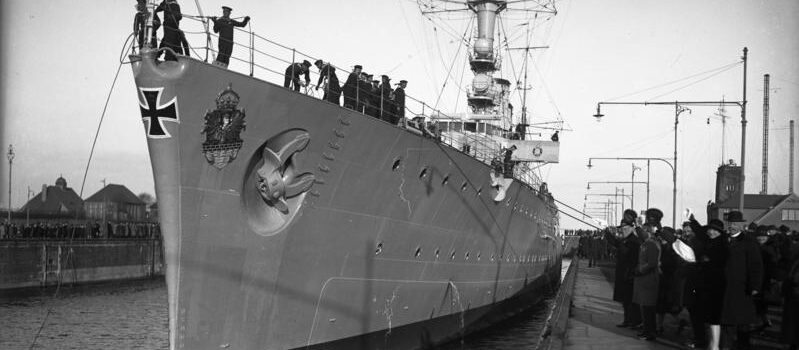

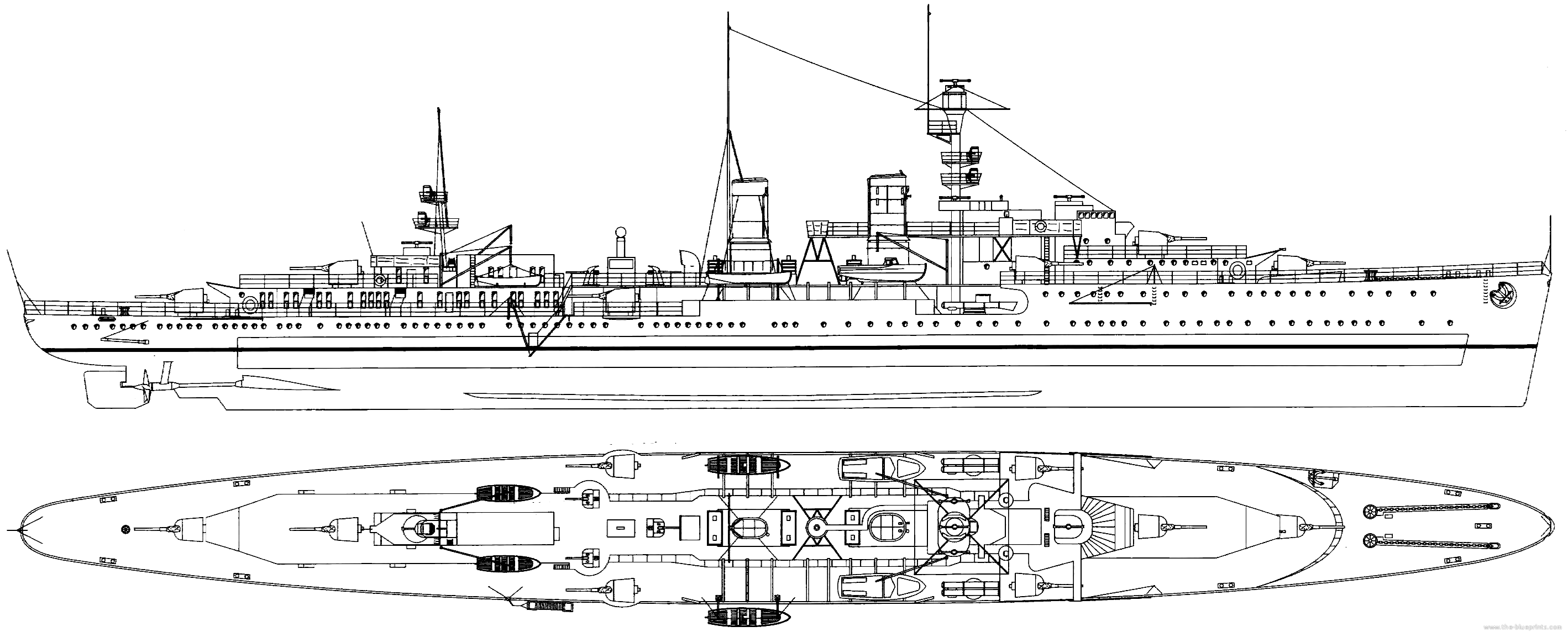
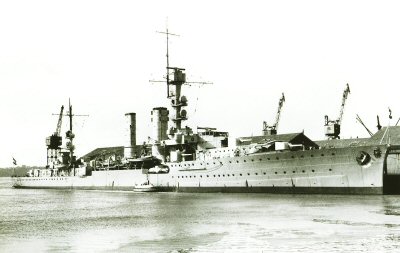
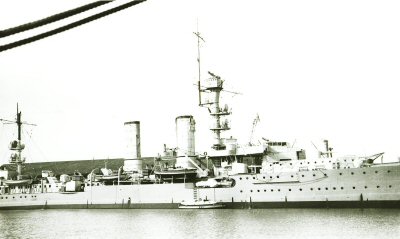
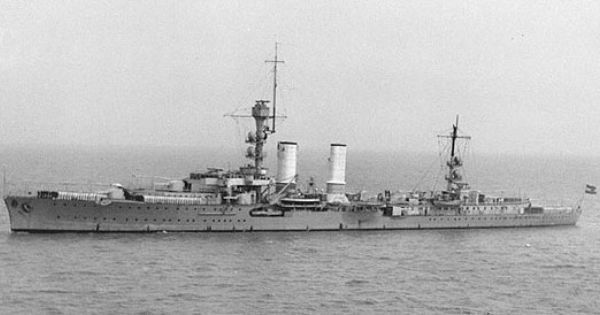
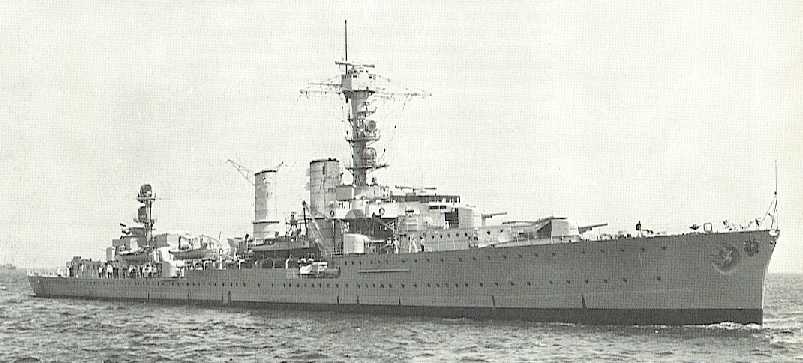
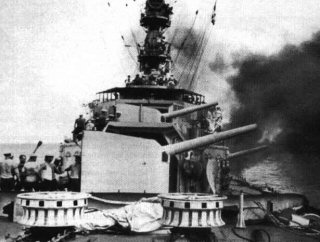
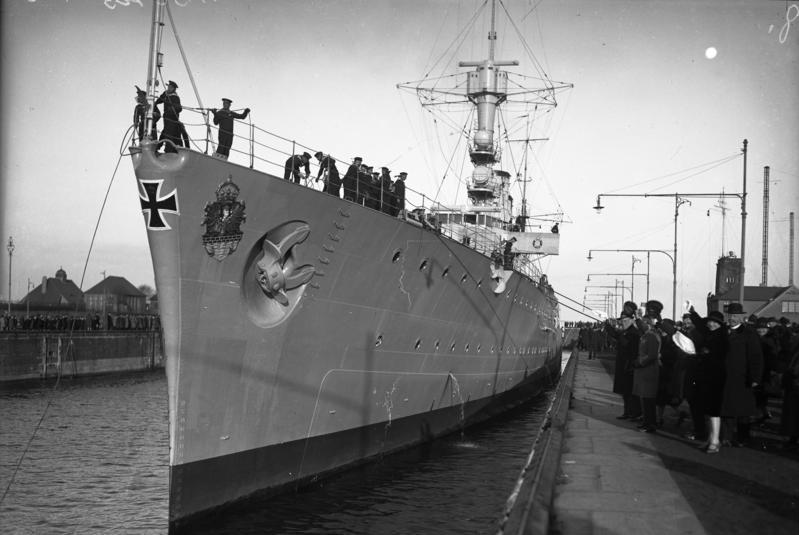
 Latest Facebook Entry -
Latest Facebook Entry -  X(Tweeter) Naval Encyclopedia's deck archive
X(Tweeter) Naval Encyclopedia's deck archive Instagram (@navalencyc)
Instagram (@navalencyc)





 French Navy
French Navy Royal Navy
Royal Navy Russian Navy
Russian Navy Armada Espanola
Armada Espanola Austrian Navy
Austrian Navy K.u.K. Kriegsmarine
K.u.K. Kriegsmarine Dansk Marine
Dansk Marine Nautiko Hellenon
Nautiko Hellenon Koninklije Marine 1870
Koninklije Marine 1870 Marinha do Brasil
Marinha do Brasil Osmanlı Donanması
Osmanlı Donanması Marina Do Peru
Marina Do Peru Marinha do Portugal
Marinha do Portugal Regia Marina 1870
Regia Marina 1870 Nihhon Kaigun 1870
Nihhon Kaigun 1870 Preußische Marine 1870
Preußische Marine 1870 Russkiy Flot 1870
Russkiy Flot 1870 Svenska marinen
Svenska marinen Søværnet
Søværnet Union Navy
Union Navy Confederate Navy
Confederate Navy Armada de Argentina
Armada de Argentina Imperial Chinese Navy
Imperial Chinese Navy Marinha do Portugal
Marinha do Portugal Mexico
Mexico Kaiserliche Marine
Kaiserliche Marine 1898 US Navy
1898 US Navy Sovietskiy Flot
Sovietskiy Flot Royal Canadian Navy
Royal Canadian Navy Royal Australian Navy
Royal Australian Navy RNZN Fleet
RNZN Fleet Chinese Navy 1937
Chinese Navy 1937 Kriegsmarine
Kriegsmarine Chilean Navy
Chilean Navy Danish Navy
Danish Navy Finnish Navy
Finnish Navy Hellenic Navy
Hellenic Navy Polish Navy
Polish Navy Romanian Navy
Romanian Navy Turkish Navy
Turkish Navy Royal Yugoslav Navy
Royal Yugoslav Navy Royal Thai Navy
Royal Thai Navy Minor Navies
Minor Navies Albania
Albania Austria
Austria Belgium
Belgium Columbia
Columbia Costa Rica
Costa Rica Cuba
Cuba Czechoslovakia
Czechoslovakia Dominican Republic
Dominican Republic Haiti
Haiti Hungary
Hungary Honduras
Honduras Estonia
Estonia Iceland
Iceland Eire
Eire Equador
Equador Iran
Iran Iraq
Iraq Latvia
Latvia Liberia
Liberia Lithuania
Lithuania Mandchukuo
Mandchukuo Morocco
Morocco Nicaragua
Nicaragua Persia
Persia San Salvador
San Salvador Sarawak
Sarawak Uruguay
Uruguay Venezuela
Venezuela Zanzibar
Zanzibar Warsaw Pact Navies
Warsaw Pact Navies Bulgaria
Bulgaria Hungary
Hungary

 Bundesmarine
Bundesmarine Dutch Navy
Dutch Navy Hellenic Navy
Hellenic Navy Marina Militare
Marina Militare Yugoslav Navy
Yugoslav Navy Chinese Navy
Chinese Navy Indian Navy
Indian Navy Indonesian Navy
Indonesian Navy JMSDF
JMSDF North Korean Navy
North Korean Navy Pakistani Navy
Pakistani Navy Philippines Navy
Philippines Navy ROKN
ROKN Rep. of Singapore Navy
Rep. of Singapore Navy Taiwanese Navy
Taiwanese Navy IDF Navy
IDF Navy Saudi Navy
Saudi Navy Royal New Zealand Navy
Royal New Zealand Navy Egyptian Navy
Egyptian Navy South African Navy
South African Navy






























 Ukrainian Navy
Ukrainian Navy dbodesign
dbodesign